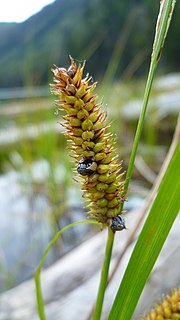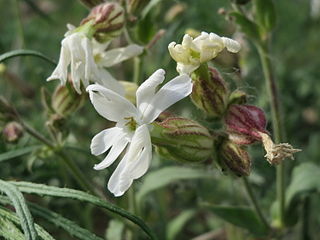
Rusts are plant diseases caused by pathogenic fungi of the order Pucciniales.

Galls or cecidia are a kind of swelling growth on the external tissues of plants, fungi, or animals. Plant galls are abnormal outgrowths of plant tissues, similar to benign tumors or warts in animals. They can be caused by various parasites, from viruses, fungi and bacteria, to other plants, insects and mites. Plant galls are often highly organized structures so that the cause of the gall can often be determined without the actual agent being identified. This applies particularly to some insect and mite plant galls. The study of plant galls is known as cecidology.

Botrytis cinerea is a necrotrophic fungus that affects many plant species, although its most notable hosts may be wine grapes. In viticulture, it is commonly known as "botrytis bunch rot"; in horticulture, it is usually called "grey mould" or "gray mold".

Corn smut is a plant disease caused by the pathogenic fungus Ustilago maydis that causes smut on maize and teosinte. The fungus forms galls on all above-ground parts of corn species. It is edible, and is known in Mexico as the delicacy huitlacoche; which is eaten, usually as a filling, in quesadillas and other tortilla-based foods, and in soups.

Wild rice is any of four species of grasses that form the genus Zizania, and the grain that can be harvested from them. The grain was historically gathered and eaten in both North America and China, but eaten less in China, where the plant's stem is used as a vegetable.

The smuts are multicellular fungi characterized by their large numbers of teliospores. The smuts get their name from a Germanic word for dirt because of their dark, thick-walled, and dust-like teliospores. They are mostly Ustilaginomycetes and can cause plant disease. The smuts are grouped with the other basidiomycetes because of their commonalities concerning sexual reproduction.

Ustilago is a genus of approximately 200 smut fungi parasitic on grasses.

Magnaporthe grisea, also known as rice blast fungus, rice rotten neck, rice seedling blight, blast of rice, oval leaf spot of graminea, pitting disease, ryegrass blast, Johnson spot, neck blast, and Imochi (Japanese:稲熱) is a plant-pathogenic fungus and model organism that causes a serious disease affecting rice. It is now known that M. grisea consists of a cryptic species complex containing at least two biological species that have clear genetic differences and do not interbreed. Complex members isolated from Digitaria have been more narrowly defined as M. grisea. The remaining members of the complex isolated from rice and a variety of other hosts have been renamed Magnaporthe oryzae, within the same M. grisea complex. Confusion on which of these two names to use for the rice blast pathogen remains, as both are now used by different authors.

Sugarcane smut is a fungal disease of sugarcane caused by the fungus Sporisorium scitamineum. The disease is known as culmicolous, which describes the outgrowth of fungus of the stalk on the cane. It attacks several sugarcane species and has been reported to occur on a few other grass species as well, but not to a critical amount. The most recognizable characteristic of this disease is a black or gray growth that is referred to as a "smut whip". Resistance to sugarcane smut is the best course of action for management, but also the use of disease free seed is important. On smaller scale operations treatments using hot water and removing infected plants can be effective. The main mode of spore dispersal is the wind but the disease also spreads through the use of infected cuttings. Sugarcane smut is a devastating disease in sugarcane growing areas globally.

Alternaria is a genus of Deuteromycetes fungi. Alternaria species are known as major plant pathogens. They are also common allergens in humans, growing indoors and causing hay fever or hypersensitivity reactions that sometimes lead to asthma. They are present in the human mycobiome and readily cause opportunistic infections in immunocompromised people such as AIDS patients.

Covered smut of barley is caused by the fungus Ustilago hordei. The disease is found worldwide and it is more extensively distributed than either loose smut or false loose smut.

Loose smut of barley is caused by Ustilago nuda. It is a disease that can destroy a large proportion of a barley crop. Loose smut replaces grain heads with smut, or masses of spores which infect the open flowers of healthy plants and grow into the seed, without showing any symptoms. Seeds appear healthy and only when they reach maturity the following season is it clear that they were infected. Systemic fungicides are the major control method for loose smut.

Ustilago avenae is a plant pathogen. Semiloose smut of oats can be found wherever oats are grown, as they are seldom treated with seed treatments. The level of treatment is low because oats command a lower sale price than other cereals and hence it is thought that treatment is uneconomic. Semiloose smut of oats, unlike loose smut of wheat and barley, can thus infect up to 80 per cent of a crop.

Ustilaginoidea virens, perfect sexual stage Villosiclava virens, is a plant pathogen which causes the disease False Smut of rice which reduces both grain yield and grain quality. The disease occurs in more than 40 countries, especially in the rice producing countries of Asia. but also in the U.S. As the common name suggests, it is not a true smut (fungus), but an ascomycete. False smut does not replace all or part of the kernel with a mass of black spores, rather sori form erupting through the palea and lemma forming a ball of mycelia, the outermost layers are spore-producing. Infected rice kernels are always destroyed by the disease.
Magnaporthe salvinii is a fungus known to attack a variety of grass and rice species, including Oryza sativa and Zizania aquatica. Symptoms of fungal infection in plants include small, black, lesions on the leaves that develop into more widespread leaf rot, which then spreads to the stem and causes breakage. As part of its life cycle, the fungus produces sclerotia that persist in dead plant tissue and the soil. Management of the fungus may be effected by tilling the soil, reducing its nitrogen content, or by open field burning, all of which reduce the number of sclerotia, or by the application of a fungicide.
Sporisorium reilianum Langdon & Full., (1978), previously known as Sphacelotheca reiliana, and Sporisorium reilianum, is a species of biotrophic fungus in the family Ustilaginaceae. It is a plant pathogen that infects maize and sorghum.
Orseolia oryzae, also called the Asian rice gall midge, is a species of small fly in the family Cecidomyiidae. It is a major insect pest of rice. The damage to the crop is done by the larvae which form galls commonly known as "silver shoots" or "onion shoots". The rice plant is stunted and the seed heads fail to develop.

Zizania latifolia, known as Manchurian wild rice, is the only member of the wild rice genus Zizania native to Asia. It is used as a food plant. Both the stem and grain are edible. Gathered in the wild, Manchurian wild rice was an important grain in ancient China. A wetland plant, Manchurian wild rice is now very rare in the wild, and its use as a grain has completely disappeared in Asia, though it continues to be cultivated for its stems. A measure of its former popularity is that the surname Jiǎng, one of the most common in China, derives from this crop.

Microbotryum violaceum is a host-specific anther smut (fungus) disease that infects Silene latifolia and sterilizes the host plant. When infected with this disease, the flowers generate pathogenic spores, which can then be transferred to other plants by pollinating insects. Therefore, this disease is sometimes classified as a sexually transmitted infection.
















